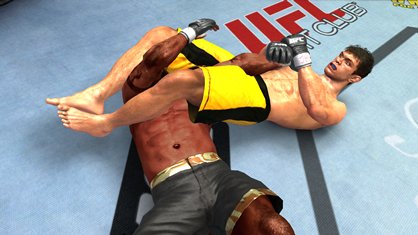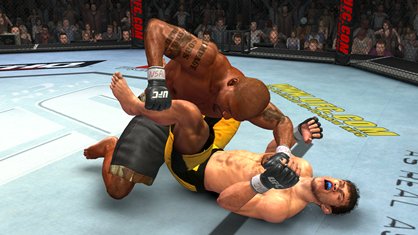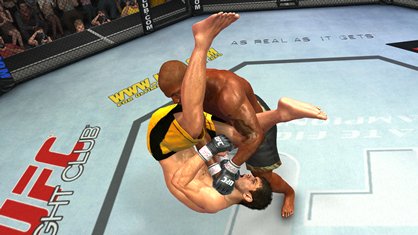Do you want to be an Ultimate Fighter?” excitable UFC commentator Mike Goldberg is fond of whooping – usually when someone in the octagon (UFC bouts take place in a cage-like octagonal arena) has just taken an elbow to the face, a shin to the ribs, a punch in the kidneys or an illegal knee in the balls. It’s kind of a rhetorical question anyway, but until recently the answer’s been ‘not really’. Actually getting a shattered nose or broken arm isn’t that appealing, and the half-dozen videogame versions released so far haven’t been much better: even UFC president Dana White admits it. “I don’t really play videogames, and I’m really more of a Pac-Man guy,” says the man who’s reinvented the Ultimate Fighting Championship from human cockfight to pay-per-view uber-sport, “but the old games sucked.”
To be fair, it’s a difficult sport to do justice to in a videogame. Since its creation in 1993, the UFC’s evolved from a virtual street fight into a legitimate sport, where every participant is an expert in Muay Thai, Olympic-style wrestling, and Brazilian Jiu-jitsu. Bouts can be over almost instantly – the quickest knockout in UFC history happened in eight seconds – or last for 25 minutes. Almost every event sees a fighter try something that’s completely new to the octagon – after a recent win secured by a weird, inverted armbar move, welterweight Dustin Hazelett explained that he’d never even attempted it before. And, yes, there’s a lot of confusing grappling on the ground: to the uninitiated it looks like rolling around, but it’s really a game of sweaty human chess where uneducated fighters risk having shoulders snapped and knees popped.

So the question is, how do you recreate all that? After looking at pitches from developers who worked on Fight Night, Call of Duty and Tony Hawk’s, the UFC decided that Smackdown developer Yuke’s would do the best job. Don’t fret though, fight purists – dev duties went to the Japanese developer’s recently-formed Osaka branch, so the game engine has been built from scratch rather than cobbled together from old wrestling games. And it shows.
The first bit of good news is, you will be able to instantly spark someone out, as long as you time it right. “You have a flash knockout system where, if you make a wrong move and a blow catches you clean, you’re going down,” says producer William Schmitt. “If you shoot in for a takedown straight off the bell, and I go for a flying knee, you’ll get knocked unconscious.” Conversely, you’ll never get knocked out by a jab or a weak punch on the floor, although cumulative punches will take their toll and a ref can stop a fight because you aren’t defending yourself. “Everything that can happen in a real UFC bout can happen in our game. Getting into the game is very easy, but then you start learning the advanced stuff – so you get to mount and start throwing punches, but you could also start throwing hammer blows and elbows if you learn how to use them,” says Schmitt. Like Fight Night, there’s no health bar, so your fighter’s physical condition is your only clue to how weary they are. As we watch two of the Yuke’s staff demo the game, light-heavyweight champ Quinton ‘Rampage’ Jackson’s right eye almost swells shut after a series of vicious knees, while Forrest Griffin gets a cut on his cheek, and purple ribs after some meaty body shots. Even blocking takes its toll – Griffin takes a series of punches on the forearms, and they visibly shake.

How exactly you fight depends on who you choose to be. Every fighter has 16 stats, including submission skills, submission defence, striking power, takedowns and clinch work. Jackson, for instance, hits like a truck and has a granite chin, but Griffin has better submissions from his back and more pinpoint striking. He’s also good at ‘dirty boxing’ – holding the back of an opponent’s head and chinning them with his free hand, hockey fight style – something he resorts to when Jackson starts getting the upper hand. Trouble is, Jackson’s better at takedowns, and slams Griffin to the floor. To be successful you need to play to your strengths and approach every fight with a decent strategy. You can try virtually anything, but it’s not necessarily a good idea. Former champ Chuck Liddell, for instance, is known for his looping overhand right, not his ‘triangle choke’, so going for submissions is nota good idea. “Everybody has a base level of mixed martial arts (MMA),” says Schmitt, “but if Chuck’s on his back and the AI’s controlling him, he’s going to try to get to his feet so he can carry on striking.”
Meanwhile, on the floor, Griffin’s taking a pummeling – but this is where the game’s Jiu-jitsu comes in. UFC’s producers have been working with Eddie Bravo – black belt in Brazilian Jiu-jitsu and the first American ever to tap out one of the Gracie family (the Gracies created Brazilian Jiu-jitsu) – to get the technicalities of ground fighting right. A couple of the team have even been training themselves. “We say things like, ‘Would I push the knee down here?’” says Schmitt. “Most positions have a submission hold associated with them. Once you’re in them you can choose whether to advance your position or go for the submission. These can work off counters too, but it’s not choreographed so it doesn’t just happen.” Griffin handily illustrates this by going for an armbar from the bottom, but Rampage isn’t having it and powerbombs him onto his head with a trademark slam. Griffin holds on, so Rampage is forced to go for a more technical escape, circling around and ending up in a dominant side-control position over his opponent.

Griffin then rolls over and Rampage goes for a chokehold from the back, but the big man isn’t so good at submissions, so Griffin rolls around and ends up on top. It’s a smooth, beautifully animated sequence, and exactly what you’d see in the real UFC. And just as in the real thing, you never can tell quite what’s going to happen next – as the fighters scramble to their feet, Griffin drops his hands, sticks his chin out and taunts Rampage who, right on cue, lets a massive right hand go, and hits him, dropping him like a lumberjack. Griffin’s legs are stiffening up before he even hits the ground, and referee Mario Yamasaki jumps in to spare him further punishment. Seconds later, we’re treated to a slow-motion replay of Griffin’s face flapping like he’s in a wind tunnel as his gum shield flies through the air. So you want to be an Ultimate Fighter? There’s never been a better time.
Sign up to the GamesRadar+ Newsletter
Weekly digests, tales from the communities you love, and more


